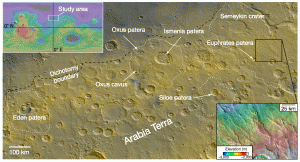The idea of giant volcanos erupting in Arabia was proposed by Joseph Michalski (Planetary Science Institute) in a talk at the Lunar and Planetary Science Conference in March 2013. Michalski and coauthor Jacob Bleacher (NASA Goddard Space Flight Center) have now published a more detailed report on their work in Nature.

SUPERVOLCANOS IN ARABIA. Close examination of northern Arabia reveals a new volcanic region on Mars. Several depressions, widely taken to be ancient impact craters, may have been supervolcanos that erupted giant quantities of ash and other pyroclastic debris. (Image taken from Figure 1 in the paper.)
As before, they find evidence for a new kind of volcanic eruption style in Arabia’s features. These features superficially resemble impact craters, but lack telltale craterlike details, such as upraised rims, central peaks, and so on. What they do have are caldera-like collapse features and low overall topographic relief, and they are associated with fine-grained deposits and ridged-plains lava flows — all suggesting a volcanic origin.
These structures in Arabia, the team writes, “are of the same scale and morphology as terrestrial supervolcanos.” On Earth a supervolcano is defined as a volcano that can produce at least 1,000 cubic kilometers of volcanic materials in an eruption. The Yellowstone volcanic region is a typical example.
Why would large calderas associated with explosive volcanism occur in northern Arabia Terra? Michalski and Bleacher argue, “A combination of regional extension and thermal erosion of the lower crust in the Late Noachian to Early Hesperian led to a rapid ascent of magma in the northern Arabia Terra region.”
They note that the lower gravity and atmospheric pressure on Mars mean that gas bubbles will form in rising magma more easily than on Earth. “As a result,” they say, “pyroclastic [explosive] eruptions would be more commonly associated with basaltic volcanos on Mars than on Earth.”
This would be especially true if the magma rapidly rose and erupted instead of being stored in magma chambers for long periods, letting gases escape — as scientists think happened at younger, large shield volcanos.
After their experience with Arabia Terra, Michalski and Bleacher suggest scientists keep looking further. “Other eroded topographic basins in the ancient Martian highlands that have been dismissed as degraded impact craters should be reconsidered as possible volcanic constructs,” they argue. These would have “formed in an early phase of widespread, disseminated magmatism on Mars.”








